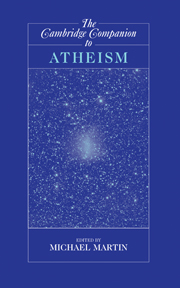Book contents
- Frontmatter
- General Introduction
- Part I Background
- Part II The Case against Theism
- 4 Theistic Critiques of Atheism
- 5 The Failure of Classical Theistic Arguments
- 6 Some Contemporary Theistic Arguments
- 7 Naturalism and Physicalism
- 8 Atheism and Evolution
- 9 The Autonomy of Ethics
- 10 The Argument from Evil
- 11 Kalam Cosmological Arguments for Atheism
- 12 Impossibility Arguments
- Part III Implications
- Index
- Series List
8 - Atheism and Evolution
from Part II - The Case against Theism
Published online by Cambridge University Press: 28 January 2007
- Frontmatter
- General Introduction
- Part I Background
- Part II The Case against Theism
- 4 Theistic Critiques of Atheism
- 5 The Failure of Classical Theistic Arguments
- 6 Some Contemporary Theistic Arguments
- 7 Naturalism and Physicalism
- 8 Atheism and Evolution
- 9 The Autonomy of Ethics
- 10 The Argument from Evil
- 11 Kalam Cosmological Arguments for Atheism
- 12 Impossibility Arguments
- Part III Implications
- Index
- Series List
Summary
Descartes, in the Meditations (1641), notes that “there are only two ways of proving the existence of God, one by means of his effects, and the other by means of his nature or essence ” (AT VII, 120). The latter, a priori path, represented paradigmatically by the ontological argument of St. Anselm (and its offspring, including Descartes' own version), has perennial appeal to a certain sort of philosopher, but leaves most people cold. The former, represented paradigmatically by the argument from design, is surely the most compelling of all arguments against atheism, and it apparently arises spontaneously whenever people anywhere are challenged to justify their belief in God. William Paley's example of finding a watch while strolling on the heath epitomizes the theme and leads, he says, to “the inference we think is inevitable, that the watch must have had a maker - that there must have existed, at some time and at some place or other, an artificer or artificers who formed it for the purpose which we find it actually to answer, who comprehended its construction and designed its use ” (Paley 1800). Until Darwin came along, this was a respectable argument, worthy of Hume's corrosive but indecisive broadside in his Dialogues Concerning Natural Religion (1779). Descartes himself subscribed to a version of the argument from design, in his notorious Third Meditation argument that his idea of God was too wonderful to have been created by him. Though Descartes surely considered himself intelligent, and moreover an accomplished designer of ideas, he could not imagine that he could be the intelligent designer of his own idea of God.
- Type
- Chapter
- Information
- The Cambridge Companion to Atheism , pp. 135 - 148Publisher: Cambridge University PressPrint publication year: 2006
- 20
- Cited by

